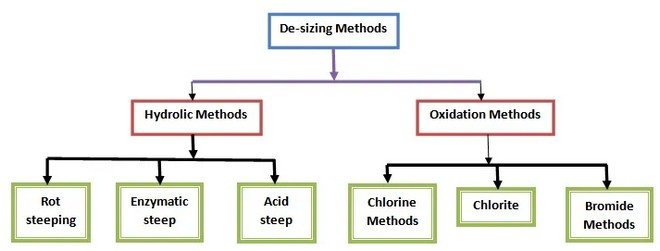DESIZING PROCESS IN TEXTILE:-
Desizing Process in Textile:-
Objectives and Methods:-
What is Desizing?
Desizing is the process in which the sizing materials are removed from the warp yarns of the woven fabrics. Warp yarns are coated with sizing agents prior to weaving in order to reduce their frictional properties, decrease yarn breakages on the loom and improve weaving productivity by increasing weft insertion speeds. If the sizes are present, they may hinder dyeing, printing and finishing processes. Desizing must be done before other wet processes of bleaching, mercerizing, dyeing, printing or finishing are carried out. The methods and chemicals used for desizing depend on the type of sizing agent used.
Fig: Desizing Process ref by printerest.
For an effective desizing process it is necessary to find out sizing products used:-
1)Size is generally used to improve the weavability of the yarn.
2) In order to avoid abrasion of the weaving instruments (i.e., reed, shuttle) on the warp threads, the warp threats are sized. To keep them smooth softeners and preservatives (to avoid mildew attack at long and damp stocking) are additionally added. It often happens that the weaver makes “after-waxing” directly at the loom in case of bad running properties.
3) A distinction is made between water-soluble and water-insoluble sizing agents, mixtures are also applied quite often.
4)Desizing can be executed in a discontinuous, half-continuous or continuous process.
Sizing products are generally natural polymers (e.g., Starch) as is or modified to improve certain of its properties with respect to the yarn to be sized (e.g., Carboxymethyl starch (CMS)) as well as synthetic polymers and co-polymers, (e.g., Polyvinyl Alcohol (PVA), Polyacrylate (PAC)) etc. Any one or a mixture of two or more sizing products are used along with waxes, fats and lubricating agents.
The major desizing process are :
1) Enzymatic desizing of starches on cotton fabrics.
2) Oxidative desizing.
3) Acid desizing.
4) Removal of water-soluble sizes.
5)) Bioscouring.
Objectives of Desizing Process:-
1) To remove the starch material from the fabric.
2) To increase the absorbency power of the fabric.
3)To increase the affinity of the fabric to the dry chemicals.
4) To make the fabric suitable for the next process.
5) To increase the luster of the fabric increase of dyeing and printing.
Factors of Size Removal Efficiency:-
The factors, on which the efficiency of size removal depends, are as follows:
1) Type and amount of size applied.
2) Viscosity of the size in solution.
3) Ease of dissolution of the size film on the yarn.
4) Nature and the amount of the plasticizers.
5) Fabric construction.
6) Method of desizing, and
7) Method of washing-off.
Methods of Desizing:-
Desizing of cotton fabric can be accomplished by physical, chemical or combination of physical and chemical mechanism, namely rot steeping, acid steeping, treatment with enzyme and oxidising agents. In desizing, the starches and polymers that are applied which are insoluble, are converted into water soluble compound to ease their removal. This is accomplished by transferring the starch into their simple sugars or simple water soluble polymers. The synthetic sizes used for man made fibers are generally water soluble and they are removed during the scouring operation. Basically there are two types of desizing methods.
A) Hydrolytic Method.
B) Oxidative Method.
Chart of Desizing methods. Ref by printerest.
A) Hydrolytic Method:-
1)Rot Steeping.
2) Acid Steeping.
3) Alkali Steeping.
4) Enzymatic Stepping.
These methods are discussed below:
1. Rot Steeping:-
The fabric is padded with warm water (40°C) and is squeezed to about 100% expression. The fabric is then allowed to stand for about 24 h at 35°C–40°C or overnight at 60°C in an open space or in an open box.
2. Acid Steeping:-
The fabric is impregnated with 2.5 g/L acid solution at room temperature (30°C) followed by storage for about 6–8 h.
3. Alkali Steeping:-
In the Alkali steeping process, the starch is removed by alkaline hydrolysis. Fabric is treated with 0.4-0.6% NaOH solution at 60-70˚C & stored for 8-10 hours.
4. Enzyme Steeping:-
The fabric is padded with 2–4 g/L a-amylases enzyme (Bactosol TK liq.), 1–2 g/L trisodium phosphate (pH 8.5–9) and wetting agents. It is then batched for 4–12 h at room temperature followed by hot and cold wash.
B. Oxidative Method:-
1) Chlorine desizing.
2) Chlorite Desizing.
3);Bromide Desizing.
4) Peroxy compounds.
5) Ammonium per Sulphate Desizing
These methods are discussed below:-
1. Chlorine Desizing:-
The fabric may be impregnated with a dilute solution of sodium hypochlorite or bleaching powder containing 1.5–2 g/L of available chlorine, squeezed and stored for 1 h at 30°C. It is then washed and antichlored.
2. Chlorite Desizing:-
A concentration of 10 g/L of sodium chlorite is sufficed to complete desizing within an hour. Sodium chlorite may be activated by a mixture of acetic acid and sodium acetate (set at pH 4) at 80°C or with ammonium sulfate (quantity equal to that of chlorite) at boil.
3. Bromite Desizing:-
The fabric is padded with 0.3% sodium bromide, a nonionic wetting agent and 0.1% sodium carbonate at room temperature. After padding, the material is stored for 6–20 min or more at room temperature or slightly higher. The fabric is washed and treated with caustic soda solution and rewashed. Best pH for bromite desizing is 10.
4. Peroxy Compound:-
The possibility of using sodium persulfate or hydrogen peroxide has been suggested but their commercial use to date is small. The material is to be saturated with hydrogen peroxide at 60°C or above with 80%–100% pickup, preferably with surfactants for better diffusion. It is then steamed for 8–10 min. 2% o.w.m. caustic soda is preferred, but can be increased to 6% for combined desizing and scouring.
Ref:-https://textilelearner.net




Comments
Post a Comment